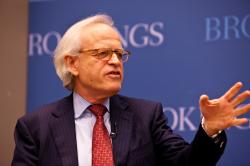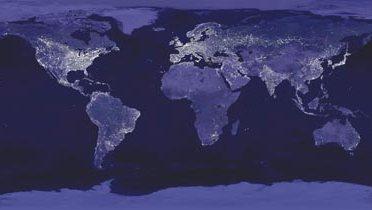Index #7: Last Four Decades
In the past month, President Obama has pressed the autocratic president of our most important Arab ally to heed the demands of his people and step down, established a workman-like relationship with China’s president, and delivered a State of the Union address that sought to “win the future.” Taken together, these critical events highlight the complexity of America’s global leadership dilemma: whether to cooperate or to compete; whether to partner with some autocrats while pressuring others. Over the past three decades, American presidents have found their ability to deal with these dilemmas affected by the shifting balances of relative power in the international system. In the seventh “How We’re Doing” Index, experts at the Brookings Institution explored some of the key data behind our leading partners and competitors. <not-mobile message=””> Continue reading below chart » </not-mobile>
Related Materials:
Past How We’re Doing indexes »
<not-mobile message=”** To see the full indicator chart, please visit brookings-edu-2023.go-vip.net on your desktop **”>
“General Welfare”
|
1980 |
1990 |
2000 |
2010 |
|
| U.S. population (thousands) | 229,469 | 254,865 | 287,842 | 317,641 |
| China | 980,929 | 1,142,090 | 1,266,954 | 1,354,146 |
| India | 692,637 | 862,162 | 1,042,590 | 1,214,464 |
| European Union | 458,130 | 471,271 | 481,403 | 501,103 |
| Brazil | 118,563 | 146,593 | 171,280 | 193,253 |
| Russia | — | 147,700 | 144,800 | 140,367 |
| Mexico | 67,570 | 83,226 | 97,966 | 108,627 |
| Egypt | 40,554 | 51,360 | 63,300 | 78,238 |
| Turkey | 42,171 | 52,436 | 62,762 | 71,428 |
| U.S. population growth (decade average) | 1.1% | 0.9.% | 1.2% | 1.0% |
| Russia | — | — | -0.2% | -0.3% |
| European Union | 0.5% | 0.3% | 0.2% | 0.4% |
| China | 1.8% | 1.5% | 1.0% | 0.7% |
| Mexico | 3.0% | 2.1% | 1.7% | 1.2% |
| Brazil | 2.4% | 2.1% | 1.6% | 1.2% |
| Turkey | 2.4% | 2.2% | 1.8% | 1.3% |
| India | 2.3% | 2.4% | 1.7% | 1.5% |
| Egypt | 2.2% | 2.6% | 2.2% | 1.9% |
| U.S. real GDP (per capita, 2005 dollars ) | $25,531 | $31,926 | $39,578 | $41,761 (2009 data) |
| European Union | $16,731 | $20,583 | $24,929 | $27,333 |
| Russia | — | $12,626 | $8,613 | $13,611 |
| Mexico | $10,422 | $10,121 | $12,095 | $12,429 |
| Turkey | $5,694 | $7,806 | $9,409 | $11,209 |
| Brazil | $7,572 | $7,179 | $7,921 | $9,455 |
| China | $524 | $1,101 | $2,667 | $6,200 |
| Egypt | $2,432 | $3,185 | $3,992 | $5,151 |
| India | $899 | $1,249 | $1,776 | $2,970 |
| U.S. inflation rate (decade average) | 7.9% | 4.7% | 2.8% | 2.4% |
| China | 1.7% | 7.2% | 7.5% | 2.2% |
| European Union | — | 10.5% | 6.8% | 2.4% |
| Mexico | — | 69.1% | 18.7% | 4.7% |
| India | 8.0% | 8.9% | 9.1% | 6.5% |
| Brazil | 41.7% | 613.8% | 560.7% | 6.7% |
| Egypt | — | 17.3% | 9.0% | 8.0% |
| Russia | — | — | 197.1% | 12.5% |
| Turkey | 34.5% | 46.4% | 76.4% | 18.5% |
| U.S. unemployment rate | 7.2% | 5.6% | 4.0% | 9.3% |
| China | 4.9% | 2.5% | 4.0% | 4.3% |
| Mexico | 1.2% | 2.7% | 2.2% | 5.4% |
| Brazil | 6.5% | 3.7% | 9.2% | 6.7% |
| Russia | — | — | 10.6% | 7.5% |
| Egypt | — | 8.0% | 9.0% | 8.1% |
| European Union | — | 8.3% (1991 data) |
9.2% | 9.6% |
| India | — | — | — | 10.8% |
| Turkey | 7.2% | 8.0% | 6.6% | 14.1% (2009 data) |
| U.S. CO2 emissions (metric tons per capita) | 21.0 | 20.1 | 20.8 | 19.3 (2007 data) |
| Russia | 15.5 | 15.8 | 9.9 | 10.8 |
| South Korea | 3.5 | 5.6 | 9.4 | 10.4 |
| Japan | 8.6 | 9.3 | 9.7 | 9.8 |
| European Union | 9.9 | 8.8 | 8.1 | 8.1 |
| China | 1.5 | 2.0 | 2.3 | 5.0 |
| Mexico | 4.1 | 4.3 | 4.0 | 4.5 |
| Turkey | 1.6 | 2.7 | 3.2 | 4.0 |
| India | 1.5 | 1.4 | 1.9 | 1.9 |
| Brazil | 0.4 | 0.7 | 1.0 | 1.4 |
| U.S. current account balance (decade average) | 0.0% | -1.9% | -1.8% | -4.6% |
| European Union | — | -0.2% | -0.1% | -0.2% |
| Brazil | — | -2.1% | -2.0% | -0.6% |
| India | — | -1.9% | -1.1% | -0.8% |
| Egypt | — | -4.1% | 1.2% | 1.0% |
| Mexico | — | -0.7% | -3.5% | -1.1% |
| Turkey | — | -1.0% | -1.1% | -3.4% |
| China | — | 0.0% | 1.5% | 5.8% |
| Russia | — | — | 4.3% | 7.9% |
“Common Defense”
|
1980 |
1990 |
2000 |
2010 |
|
| U.S. military spending (billions of dollars) | — | 505 | 377 | 663 (2009 data) |
| China | — | 18 | 31 | 98 |
| Russia | — | 266 | 30 | 61 |
| India | — | 15 | 22 | 37 |
| Brazil | — | 12 | 20 | 27 |
| Turkey | — | 14 | 22 | 19 |
| Mexico | — | 2 | 4 | 5 |
| Egypt | — | 3 | 4 | 4 |
| U.S. army (# of troops) | 774,000 | 761,100 | 471,000 | 662,232 |
| China | 3,600,000 | 2,300,000 | 1,700,000 | 1,600,000 |
| India | 944,000 | 1,100,000 | 1,100,000 | 1,129,900 |
| South Korea | 520,000 | 650,000 | 560,000 | 560,000 |
| Egypt | 320,000 | 320,000 | 320,000 | 340,000 |
“Blessings of Liberty”
|
1980 |
1990 |
2000 |
2010 |
|
| U.S. Freedom House Ratings (Political Rights, Civil Liberties, 1-7 scale) |
1,1 | 1,1 | 1,1 | 1,1 |
| Brazil | 4,3 | 2,2 | 3,3 | 2,2 |
| India ratings | 2,2 | 2,3 | 2,3 | 2,3 |
| Mexico | 3,4 | 4,4 | 2,3 | 2,3 |
| Turkey | 5,5 | 2,4 | 4,5 | 3,3 |
| Egypt | 5,5 | 5,4 | 6,5 | 6,5 |
| Russia | 6,7 | 5,4 | 5,5 | 6,5 |
| China | 6,6 | 7,7 | 7,6 | 7,6 |
| U.S. presidential approval rating (yearly avg.) | 40.6% | 66.3% | 59.9% | 46.8% |
See data sources »
</not-mobile>
During the state visit by Chinese President Hu Jintao, it was easy to imagine that world politics and global economics had been reduced to a two-power game between a democratic America and an authoritarian China. But the reality is much broader.
Despite talk of American decline, the United States remains the world’s largest national economy, at over $14 trillion per year, with a very high per capita income: $41,000. Right next to us is the oft-ignored European Union. The combined economy of their 27 member countries is actually $2 trillion per year larger than ours. And while newer members from Eastern Europe are on average poorer, they will continue to grow. Overall, the Western alliance still leads.
China’s extraordinary transformation, with its advanced infrastructure and rising living standards, is well known. But since 1980, emerging democracies such as Brazil, Mexico, South Korea and Turkey have made their own great leaps forward. China’s average income per capita – at just over $6,000 – is still only about half that of Mexico and Turkey and one-seventh that of the United States. In the past decade India, too, has made dramatic reforms and is quickly making up ground.
Meanwhile, non-democracies with heavily constrained market economies, such as Egypt, continue to falter with low economic output, high inflation and high population growth. In all likelihood, emerging and established democratic powers will shape global economics and politics well into the next century. Unless the Arab world makes similar reforms, it will be left further behind.
Some of this is simply a matter of demographics. Since 1980, the U.S. population has grown about 36 percent, adding more than 80 million people through immigration and a relatively high birthrate. That’s about four times as fast as the E.U. and Japanese rates over that time; the U.S. growth rate has been 50 percent faster than China’s over the past decade. Indeed, China’s population growth rate of 0.7 percent will eventually become a significant constraint on its economic growth.
The populations of emerging democracies such as India and Mexico have grown much faster. Provided they can overcome structural and governance challenges, their fast-growing economies will occupy an ever greater share of global gross domestic product. The biggest population problems come from countries such as Egypt, whose nearly 2 percent growth rate is too fast for its sputtering economy to provide for the employment needs of an increasingly young workforce.
What is critical for all these countries – and especially for the United States – is to find greater balance in exports and imports. Trade liberalization has, by and large, been good for all countries, helping to lift billions out of poverty. Still, growing trade imbalances encourage financial instability and undermine sustainable job creation. And democracies have a hard time achieving domestic consensus on how to move forward.
And all of this growth has had an impact on the environment. Total greenhouse gas emissions have grown more than 50 percent, from about 19 billion tons of CO2 in 1980 to more than 30 billion tons today. Most of these emissions have come from industrial economies, with the United States making the largest contribution. But whereas emissions are leveling off in the industrial world, they continue to rise dramatically in nearly all emerging powers.
How does economic growth translate into military power? The United States still has the world’s largest military by far. China has replaced Russia as the second-largest military by spending, having grown fivefold, though its defense spending is still a small fraction of the United States’. Importantly, all countries seem to be doing more with fewer troops. In fact, modernization has meant that, as a percentage of GDP, U.S. defense spending has increased only slightly, while China’s spending has actually dipped. With the growing U.S. deficit and record debt level, compared with China’s dramatic surpluses, it will be harder to sustain current levels of U.S. defense spending and easier for China to increase its military capabilities.
What does this all add up to? The United States remains the world’s leading nation – economically, politically and militarily. New partners and competitors are rising fast but in complicated ways. Most of these nations are market democracies, with civilian control of the military. The real question is not whether they will catch up – many will – but whether the United States can continue to grow in a way that lifts all boats, and whether it can help shape an emerging global order that avoids conflict and encourages greater freedom.
See also:
» State of Metropolitan America—portraying the demographic and social trends that shape our nation’s metropolitan areas
» GovWatch—tracking the progress and performance of our institutions in economic recovery
» MetroMonitor—a barometer of the health of America’s 100 largest metropolitan economies
Sources:
Population:
World Bank Development Indicators, International Monetary Fund World Economic Outlook.
Population Growth Rate:
International Monetary Fund world Economic Outlook.
Real GDP per capita:
World Bank Development Indicators.
Inflation:
International Monetary Fund World Economic Outlook.
Unemployment:
International Monetary Fund World Economic Outlook.
CO2 Emissions:
World Bank Development Indicators.
Current Account Balance:
International Monetary Fund World Economic Outlook.
Military Spending:
Stockholm International Peace Research Institute.
Troop Levels:
“Military Balance,” International Security & Counter Terrorism Reference Center.
Freedom House Ratings:
Freedom in the World Annual Reports, Freedom House.
Presidential/Congressional Approval ratings:
Gallup.





